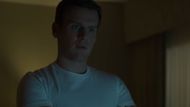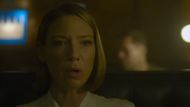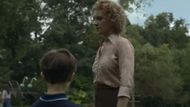Mindhunter is widely considered one of the most intriguing shows on the criminal and human mind. Executively produced by David Fincher and others, the psychological crime thriller is based on the nonfiction book, Mindhunter: Inside the FBI’s Elite Serial Crime Unit, by John E. Douglas and Mark Olshaker. The show aired for two seasons and garnered widespread critical acclaim and love from its viewers. The show focuses on the characters, Holden Ford and Bill Tench, played by Jonathan Groff and Holt McCallany, who are a part of the Behavioral Science Unit at the FBI and cover criminal profiling of serial killers. Set in the 1970s, the show is a dramatized version of the book and therefore has some major differences. Here are 10 of them.
Wendy Carr's minor role in the book, the dramatization of the show, and other differences between Mindhunter, the show, and the book
1. Debbie Mitford is fictional

Mindhunter is a show that is primarily focused on the adventures of Holden Ford and Bill Tench. The series is all about the duo travelling across the US and interviewing some of the most dangerous serial killers to understand their psychology. However, the show also diversifies and looks into the personal lives of Ford and Tench. Even though the two are consumed by their job, the dating life of Ford and the marriage of Tench are also portrayed. In the first season, viewers are introduced to the character of Debbie Mitford, who becomes Ford’s girlfriend and is a post-graduate student who knows about psychology. In an interview, executive producer David Fincher stated that he and the writers wanted to create a character who knew more about psychology than Ford. However, no such character exists in the book. Mitford’s character not only teases out context and exposition, but it also develops Ford’s character outside of his job.
2. The detectives are fictional

As mentioned above, Netflix’s show Mindhunter is based on John Douglas’ and Mark Olshaker’s book. However, the book that inspires the show is written from Douglas’ viewpoint and is full of facts. Therefore, the book does not have any dramatization. However, David Fincher decided that since he would be making a series on the events outlined in the book, he needed to add characters and plot. Therefore, the character of Holden Ford was created, which is a stand-in for Douglas. Even though Ford is based on Douglas, the show creates a whole new character arc for the character and is only inspired by the real-life Douglas. Similarly, Bill Tench is only inspired by the FBI agent Robert Ressler, but the character has his storyline. The creation of inspired but independent characters allows the show to become compelling. The series is authentic to the central message of the book, but it adds its flair to the characters.
3. The BTK Criminal is not mentioned in the book

Douglas’ and Olshaker’s book is only made up of interviews from captured criminals. It does not have the characters of Ford and Tench, and it does not even deal with any of the serial killers that were active at the time. However, Mindhunter is a series, and the creators had to showcase Ford and Tench trying to apply all the theory they had learnt from the past criminals, onto someone who is presently killing. Therefore, the first season of the show begins to interweave an unnamed character who looks like the real-life murderer Dennis Radar, AKA, the BTK killer. The first season introduces him partially and focuses on his dubious activities. In season 2, the character is still in the shadows, and his character is being developed strategically. Therefore, even though the BTK killer was a real person, the entire storyline around him was created especially for the show and is not in the book.
4. Wendy Carr has a minor role in the book

The book on which the show Mindhunter is based includes only a slight mention of the woman on whom the character of Wendy Carr is based. Even though Carr’s character is almost entirely fictional in terms of its storyline, it does derive inspiration from a real woman. In the show, Carr is the backbone of the Behavioral Science Unit (BSU) and is a genius psychology professor who helps organize the research material that Ford and Tench have brought back from their interviews. However, in the book, the focus is entirely on John Douglas’ work. However, in real life, the BSU was a large team with many dedicated individuals and included a forensic nurse called Ann Wolbert Burgess. Even though she is barely mentioned, the writers of the show decided to use her as an inspiration for Carr’s character and showcase a woman’s strength and role in the show.
5. Some names are created for the series

Changing the names of the people involved is an important aspect in shows and movies that deal with sensitive real-life topics. This helps protect the victims and also keeps the series away from any legal troubles. Therefore, many of the characters' and victims’ names were altered in the show. Even in the book from which Mindhunter is inspired, there have been a few changes in the names of the real-life victims. In the show, however, many more names have been changed. In the show’s first season, the character of Bevelery Jean Shaw was discussed, which has been altered to protect the real person’s identity. The series also tweaked the names of the dangerous criminals that Ford and Tench interviewed. While the cases on the show are authentic and accurate, the names have been changed.
6. The lead characters make faults in the show

In Douglas’ and Olshaker’s book, the focus is on the psychological aspect of the people who were interviewed and the assessments that Douglas made of the people in each chapter. These assessments took some time to be proven right, but Douglas’ research was ultimately given credit. Therefore, in the book, the author makes no mistakes and carries on his work with accuracy. However, Mindhunter is a dramatized version of the novel, and therefore, the characters created are complex and have to face challenges. In the series, Ford and Tench make mistakes along the way as they begin their journey in criminal profiling. With these mistakes, the lead ends up learning more, and the characters feel authentic and human. Therefore, while the book is a straightforward collection of all the research that the authors did during their work on criminals and is therefore free from all errors, the show takes on a more dramatized approach and shows its characters committing mistakes.
7. The show is less disturbing than the book

One of the biggest reasons that made Mindhunter popular was its gritty and gruesome look at the criminals and their crimes. The show tackles hardened criminals and essentially gives them a platform to recount their crimes in vivid detail. However, fans of the show might be surprised to learn that the show is far less terrifying than the book. As is rightly said, facts are stranger than fiction, and the book showcases that. The novel essentially offers a first-hand account of the criminals and their crimes and presents them in a matter-of-fact documentary manner. It does not tiptoe around the graphic details and instead lays them out plainly for the reader. This plainness makes the book even more sinister and unnerving. In the book, many of the crimes and the psychology of the criminals highlight the extreme lengths to which a human mind can commit atrocities. Further, the book can share more details and therefore goes in-depth for each case, which reveals even more disturbing details. Shows, on the other hand, have to consider many things like paucity of time, the impact it can have on the viewers, and the dramatic effect.
8. The book and the show handle the topic of psychology differently

Viewers of the show who have read the book will note that there is a subtle difference in the way the book and the show, Mindhunter, tackle the subject of human psychology. The book by Douglas and Olshaker was released in 1995, a time when psychology was still a new and understudied subject. Therefore, the book approaches the subject of criminal psychology triumphantly and wants to show its merits to the readers of the book, who are still uninformed about the subject. However, in the present time, many people now have a better understanding of psychology and understand the merits of researching the criminal’s mind. Therefore, the show does not have a huge celebratory tone towards the subject. Instead, it highlights that these notions were already present underground and had been ignored and underappreciated. Ford and Tench’s research brought psychology into the mainstream world.
9. The show adds depth to the characters and dramatizes the story

As mentioned before, Mindhunter is a show based on a book that only has accounts of the interviews conducted by the authors and the assessment of those interviews. However, the show had to be dramatized to make it compelling and worth watching. Therefore, the show creates all the lead characters from scratch and gives them various storylines and conflicts to keep the story moving. Further, it even dramatizes parts of the story to keep it interesting and in sync with the plot of the series. Both novels and TV shows, therefore, have a very different structural point of view. Nonfiction books just offer information and are not concerned with drama and characters. However, shows are made from the viewpoint of viewers and have to be interesting enough to watch. Therefore, the moral conflict that Ford faces, the complex marriage of Tench are all fictional plot points that have been created to build a story. Backstories and personal lives have to be made up, and the characters have to go through ups and downs to keep the viewers engaged.
10. The hospital scene with Kemper has been tweaked

Mindhunter has many heart-racing moments that make the show worthwhile. One such famous scene occurs towards the end of season 1 of the series. Ford has always been fascinated with Kemper in the show, and he once again meets him in a hospital room. While Kemper has always maintained a deceivingly calm persona in front of Ford, in the hospital scene, he shifts and remarks how easily he can take Fold out right then and there. The conversation is disturbing and brings Kemper’s true colors to light. While such an interaction is detailed in the book, it didn’t involve John Douglas, the man on whom Ford is based. Instead, the conversation happened between Kemper and Robert Ressler, the man on whom Tench is based. However, the show decided to show Ford and not Tench as Ford was enamored by Kemper since his interview with him, and it felt more in sync with the show’s plotline. In real life, Ressler had to call the guards while Kemper mentioned that he was merely joking.
